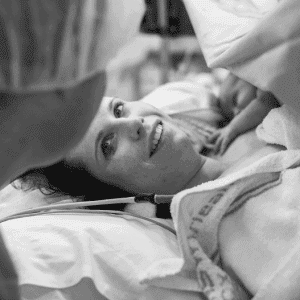Optimising Your Childbirth Experience
Sheena Byrom OBE
Consultant Midwife, Director All4Maternity
@sheena_byrom
Summary
Giving birth to your baby is probably on your mind right now, and there are things you can do to increase the chance of you having a positive experience. How you give birth to your baby can impact on how you feel afterwards when you meet your baby, and throughout your life. Evidence tells us that the experience of childbirth is important to women whatever their background or culture1 and although your focus may be on ensuring your baby is safe and healthy, we want to encourage you to believe that you matter too. Having a baby can be an empowering and life affirming experience, and it’s perfectly right that you should want and aim for that.
A good birth

Image credit: Eva Rose Birth Photography
I imagine that you’ll be asking yourself, and others, what you can do to do increase the possibility of having a good birth. What matters to you? That poses another question. What kind of birth do you want? Where do you want to have your baby? Who should be there? Whilst I can’t give you a 100% guarantee, I can share information and resources that may help you with some of these questions. Before you think about giving birth, I would like to encourage you to concentrate on your pregnancy, your baby growing inside you, touching your belly and talking to her, really connecting with her as much as you can. If you can do this regularly whilst taking some time out – it may help you to feel grounded, relaxed and in tune with your little one.
Where to start…
-
Feeling the Fear
First of all, I’d like to mention the issue of fear. You may not be afraid at all, but many pregnant women and people report feeling fearful and anxious about giving birth either due to watching TV programmes about childbirth or reading horror stories on social media or in the news. Being fearful doesn’t help you or your baby it can be harmful to you both if you are consistently stressed. Whilst some fear is useful as it protects us i.e. when crossing a busy road it can help us to be careful. But fear can strangle us, especially if it’s unfounded and unnecessary due to overthinking. I suggest that you ‘feel the fear’ and ask yourself what it is you’re afraid of, and then find out how to overcome your anxiety. For example, you may be worried about the contractions during labour and how you will cope. It’s a common worry! There are many excellent books and websites (listed below) to help you understand why you have contractions, what happens to your uterus and your body when they start and what things might help you to get through them. Once you have gained this knowledge, hopefully, you’ll feel more settled.
-
Finding the facts
They say knowledge is power, and I have to agree! Seeking out information on pregnancy, birth and early years is exciting but can be overwhelming. A word of caution here; it’s important to seek out reliable websites and books as nowadays anyone can publish their views and opinions on the web, and even in texts. We humans tend to go with opinions that fit our long-held beliefs and traditions – that’s a normal response. It’s not easy as there are no clear answers to anything and robust evidence relating to childbirth is sparse. However, there are some sensible informative resources available which include the details of any relevant research including critiques. So, I’ve listed some trustworthy resources below to help you.
-
Circle of support
Having people around who understand what you want and need is important. They may include family and friends or be folks that you’ve connected with online. They need to know your wishes and to feel the importance of those wishes. At least one of those individuals will be with you when you go into labour. Having continuous support can improve outcomes for you and your baby and help reduce the negative feelings about childbirth2 . You may want other supportive people contactable too, by phone for example.
-
Where to give birth?
Wherever you choose to give birth depends on where you feel safe and what environments are available. For some women giving birth at home offers them peace of mind and security, whereas other birthing people will only feel safe in a hospital where doctors are present. There are countries where all women must give birth in a hospital setting as there are no alternatives, and yet in other parts of the world such as the Netherlands and the UK, there is a full range on offer including home, birth centre or hospital. Your choice may also be influenced by your health and pregnancy, and whether you need medical assistance or midwifery led care. I have provided links below to information that will help you to make the decision that is right for you.
-
Make a plan
Once you have done your research, found your circle of support and decided what type of birth you want to aim for – it’s a good idea to make a plan or document your preferences. A birth plan is the nearest thing you have to give informed consent to your caregiver and remember you can always change your mind!3 I have shared some resources below to make it easy for you to create a birth plan, including ready-made icons4 . I also feel it’s useful to make a Plan B and to be clear about your wishes in this document too. For example, if you have to have an operative birth, you want your birth partner to stay with you and your baby to be close.
-
Your body, your baby
The final tip from me to you is to keep remembering that you and your baby belong to you! During your time searching for knowledge, learn about the fundamental function of your body during pregnancy, childbirth and the weeks afterwards. It’s the most important part because it will give you a basis to reflect on when you are presented with options and treatments. So, keep as close to following the physiological functions of your body as possible, avoiding interventions that may not be necessary. This includes all types of birth too, so if you are planning a CS for example, ask about optimal cord clamping and skin to skin contact – these practices optimise both your and your baby’s physical and psychological well-being. If you have any non-emergency issues and your midwife or doctor offer to intervene, consider the BRAN (or BRAIN) acronym6 and take your time. You can always ask for a second opinion, and there are excellent websites listed below for you to gain further knowledge on decision making including support.
Final thoughts
Exciting times! I suppose my message to you from my position as a midwife, mother and grandmother is that YOU can be in control of what things you want and need, even if the birth journey you planned for take takes a turn in a different direction. Try to focus on staying centred and calm during pregnancy and talk to your baby, it can help you both. Read as much as you can about your body, and how it works during childbirth from RELIABLE sources – many are listed below. Seek out those who you trust to support you. Tell them what matters to you and why. Think about where you would like to give birth. Write down the things that make you feel safe and why. Make a birth plan or write down your preferences including a plan B. Give a copy to your midwife and stick the other in your hand-held records. Finally, remember that this is your time. You are about to become a mother and the time is special. I hope my words are helpful to you in some way, and I wish you a very happy birth day.
Links to resources
 Websites
Websites
Doula’s Of North America International
Dr Sara Wickham – Midwife, Researcher
Dr Rachel Read – Midwife, Researcher
Dr Sarah Buckley – GP and Author
Association for Improvements in Maternity Services
Five X More Pregnancy and Parenting App
 Books
Books
The Hypnobirthing Book by Katherine Graves
A Passion for Birth by Sheila Kitzinger
How to have a baby by Natalie Meddings
Mindful Hypnobirthing by Sophie Fletcher
References
- WHO. WHO recommendations: intrapartum care for a positive childbirth experience. World Health Organization. https://www.who.int/reproductivehealth/publications/intrapartum-care-guidelines/en/. Published 2020.
- Hodnett E, Gates S, Hofmeyr R, Sakala C. Continuous support for women during childbirth. – PubMed – NCBI. Ncbi.nlm.nih.gov. https://www.ncbi.nlm.nih.gov/pubmed/23857334/. Published 2020. Accessed April 6, 2020.
- Dahlen H, Hazard B. Don’t throw the birth plan out with the birth water! – THE ETHICS CENTRE. THE ETHICS CENTRE. https://ethics.org.au/dont-throw-the-birth-plan-out-with-the-birth-water/. Published 2020.
- Milli H. FREE Visual Birth Plan Icons from The Positive Birth Book | Positive Birth Movement. Positive Birth Movement. https://www.positivebirthmovement.org/visualbirthplanicons/. Accessed April 7, 2020.
- Hill M. The Positive Birth Book: A new approach to pregnancy, birth and the early weeks. Pinter & Martin Publishers. https://www.pinterandmartin.com/the-positive-birth-book. Published 2020.
- Wickham S. What is the BRAN analysis? – Dr Sara Wickham. Dr Sara Wickham. https://www.sarawickham.com/questions-and-answers/what-is-the-bran-analysis/. Published 2020.













